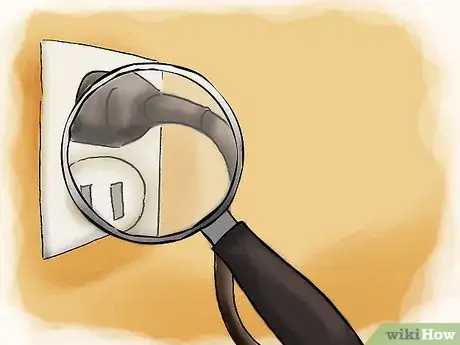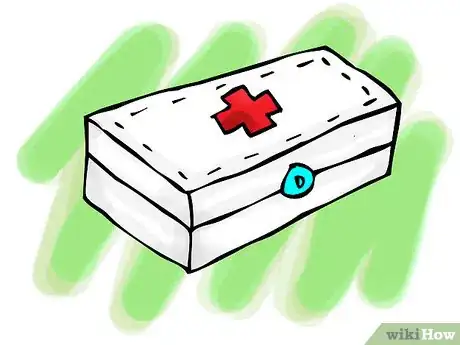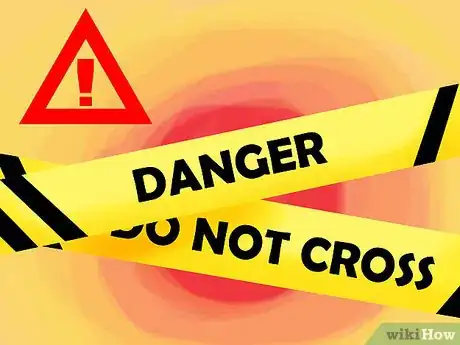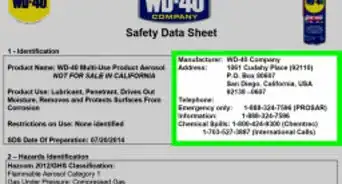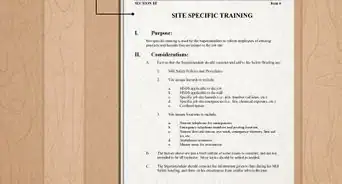wikiHow is a “wiki,” similar to Wikipedia, which means that many of our articles are co-written by multiple authors. To create this article, 12 people, some anonymous, worked to edit and improve it over time.
This article has been viewed 213,650 times.
Learn more...
The best way to reduce accidents in the workplace is to be proactive with prevention. An ounce of prevention is worth a pound of cure. There are many ways to prevent accidents but in implementing these methods, you need to be consistent and communicate your expectations clearly. To successfully reduce accidents in the workplace, review the following list of safety suggestions.
Steps
General Policies
-
1Put formal safety policies and procedures in place. Create a company handbook that lists out the steps that must take place in order to prevent accidents in the work place. Include instructions such as how to store dangerous and toxic items and where certain product should be stowed to ensure safe storage and retrieval.[1]
-
2Put someone in charge of safety in your company. Discuss the current safety policies with this safety coordinator, and work on a plan to make sure that they are adhered to. Confirm that the person is aware of all the responsibilities associated with safety. Express your support to this person and arrange to meet on a regular basis to discuss concerns about and solutions to further accident prevention.[2]Advertisement
-
3Communicate your expectations for a safe work environment. Let your staff know on a regular basis that safety is a major concern in your business. You can do this verbally and you can reiterate your expectations in memos. You can also post safety information throughout your facility.
- Words are one thing, but act accordingly, too. If someone encounters a possible safety hazard, move quickly to correct it. Don't wait for it to correct itself or assume that someone else is going to do it.
- Ask your employees whether they have any suggestions about improving workplace safety. One safety coordinator is certainly helpful, but a handful of ears and eyes is almost always preferable to just one. Create an anonymous input form that employees can fill out at their discretion.
-
4Inspect your facility regularly with your safety coordinator. Make certain that your staff is following safety policies at work. Check areas that are of concern and ensure that precautions have been met. If you see an area that is cause for concern, discuss it with the person responsible, and then arrange a meeting with all the staff to further communicate the concern and ensure that it does not happen again.[3]
-
5Have the right tools available so that you or your employees don't have to improvise. Asking your employees to improvise pretty much says that you don't take safety seriously.
- For example, if you have a storage area that includes high shelving, ensure that you have a safe ladder or step-stool available so that you or your staff members are not forced to climb on boxes of furniture to retrieve items.
-
6Schedule regular training for all scenarios that pose a risk for accidents. Training should involve methods in picking up and carrying heavy objects and how to use mechanical equipment and tools.[4]
- The type of training will depend on the type of business you are running. Some businesses such as restaurants and warehouse facilities will have more training than others.
- Trainings should be scheduled for all new employees and for all employees annually. Employees may think of it as a hassle, but they should be reassured knowing that the company takes their health and safety seriously.
Specific Policies
-
1Be prepared for a fire in your workplace. Fires are potentially devastating occurrences, putting many businesses, especially restaurants, in jeopardy. Ensure that your workplace is properly protected against the possibility of a fire to cut down on accidents:[5]
- Make sure smoke detectors are installed and have batteries.
- Make sure that fire extinguishers are present and properly charged. Ask your fire department, if necessary, to give you training on how to use a fire extinguisher.
- Plan your escape routes. Know where your nearest exits are and how employees can access them quickest.
-
2Consider investing in first-aid training or, at the very least, a first aid kit. First-aid training won't keep the accident from happening in the first place, but it could help keep any injuries incurred during an accident from getting out of control.
- Invest in a first-aid kit for each floor of your workplace. Place it in a strategically central location that is easily accessible.
-
3Create incident reports after each workplace accident. If an accident occurs in your workplace, write up an incident report. Investigate what happened, who was involved, how the accident might have been prevented, and recommendation for further procedures. At the very least, an incident report will foster awareness and possibly act as a deterrent for future accidents.[6]
-
4Make sure your workplace entrances and exits are fully operational and easily accessible. If your employees need to get out of the building quickly, make sure that their exits aren't blocked by any large or unmovable objects. This is more than just a workplace violation: this is a potential life or death matter.
-
5Clearly mark potential safety concerns with the proper signage and instructions. If an electrician is rewiring an area of the workplace, or if a crew is doing construction on a piece of railing, inform your employees by memo and by placing an appropriate, visible sign near where the potential hazard could occur. Don't assume that people are smart enough to act accordingly. Spell it out for them very clearly.
References
- ↑ https://www.ccohs.ca/oshanswers/hsprograms/osh_policy.html
- ↑ https://www.citizensinformation.ie/en/employment/employment_rights_and_conditions/health_and_safety/health_safety_work.html
- ↑ https://www.ccohs.ca/oshanswers/prevention/effectiv.html
- ↑ https://www.osha.gov/shpguidelines/education-training.html
- ↑ https://www.hsa.ie/eng/Topics/Fire/Fire_Prevention/
- ↑ https://www.hni.com/blog/bid/92062/workplace-incident-report-7-immediate-steps-to-take-after-an-injury
About This Article
It’s important to stay up to date with safety procedures to reduce accidents in your workplace. Make sure that you have working smoke detectors and that fire extinguishers are accessible in every area. Communicate any potential safety concerns, like rewiring and areas under construction, to all of your employees with clear signage and email memos. You should also hire a safety inspector to check your workplace regularly to identify any potential hazards. Consider holding regular training sessions to teach all of your employees how to stay safe in your workplace. You should also have accessible first aid kits and train a few staff members in first aid, which will prevent minor accidents from developing into worse injuries. For more tips, including how to create safety policies for your company handbook, read on!



